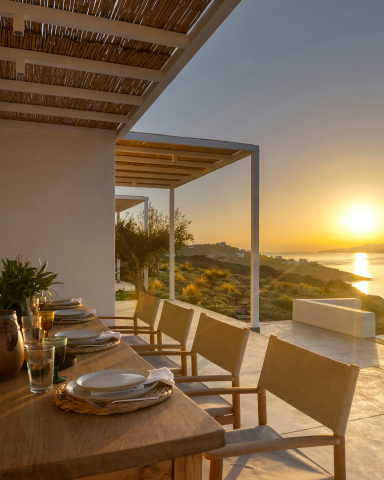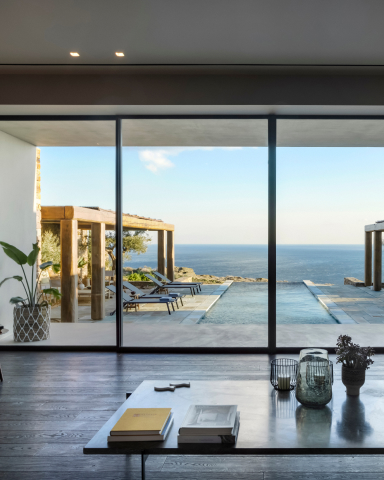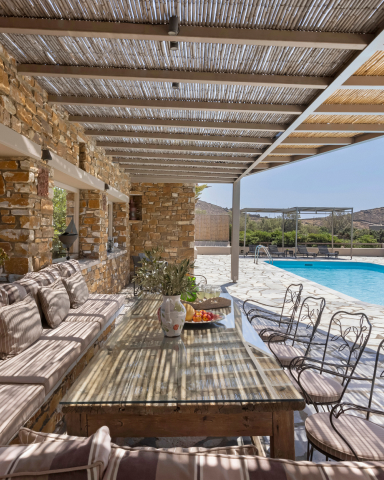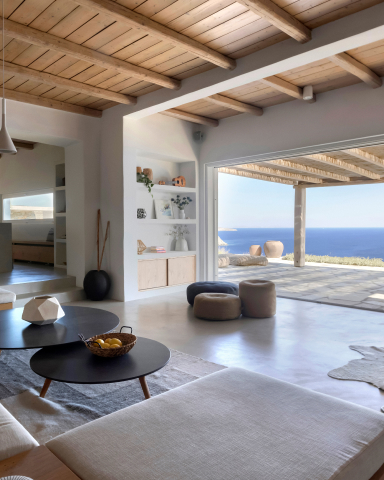The history of Tinos: harnessing the wind and pigeon-fancying

Welcome to Tinos, a gem in the Aegean Sea, where history whispers from every corner. This enchanting Greek island has had a fascinating journey through time, marked by events such as the Fourth Crusade and the expansion of the Maritime Republic of Venice. Head below to learn how Tinos's history continues to captivate travellers today.
What makes Tinos unique
It’s not always easy to discern exactly what makes a place unique. To find out you may have to dig a little deeper, explore a bit further, or read more widely. This is not the case with Tinos, however, as its most emblematic and distinguishing features are on full show. All it takes is a drive into the interior, where you will soon come across the curious sight of hundreds of proud windmills and elaborate dovecotes dotting the landscape.
How these constructions came to be built, and how important they were for the island’s inhabitants, is a fascinating tale that begins with the arrival of the Venetians at the beginning of the 13th century.

The windmills of Tinos
Although windmills are a common site throughout the Cyclades, on Tinos they are remarkable both for their number (estimates vary between about 120 and 130), and for the integral role they played in island life until the 1980s.
On assuming control of Tinos, the Venetians quickly recognised the island’s agricultural potential, particularly where the cultivation of wheat was concerned. And with its breezy climate (Tinos is sometimes referred to as the Island of Aeolus, after the Greek god of wind), windmills were the obvious choice when it came to transforming the harvest into flour. Soon, windmills were popping up in strategic locations near tracks and roads across the hilly terrain of the island’s hinterland.
Classic Tinian windmills had a circular stone body and a conical roof. Laid out over three floors, they functioned as most pre-industrial windmills did: the sails rotated a shaft, which, via a system of cogs, turned a second, upright shaft. This latter powered the millstones.
As the island’s population grew, so did the need for wheat and flour, and more windmills were built. So effective were they that soon Tinos began exporting flour to its neighbouring islands and beyond, a trade that brought significant wealth.
During the Second World War, Tinos’s millers heroically defied the German occupying forces (who requisitioned all flour for their own requirements) by milling secretly at night to feed the island’s inhabitants.
After the war, Tinos’s wheat-growing and milling traditions began to fade. Cheaper flour was brought by ship from the mainland, and, one by one, the windmills fell into disuse. Today, some are used as weather stations by amateur meteorologists, while others have been converted into private homes. Sadly, many lie abandoned, an evocative testament to a lost world.
The dovecotes of Tinos
The Venetians had a passion for pigeons (more correctly called rock doves), which they brought with them to Tinos. They built peristeriones to house their beloved birds, thus beginning a tradition that would see over 1,000 (some say upwards of 1,300) dovecotes spring up across the island. A great many survive today, and they are an integral part of Tinos’s unique landscape.
Pigeon-fancying was not just a pastime, however, for the inhabitants of the dovecotes also played a key role in the island’s agroalimentary system: they were a valuable source of protein when times were hard; and their droppings were an excellent source of natural fertiliser for the intensively farmed land.
The sheer number of dovecotes on Tinos is remarkable, but their ubiquity is only half of the story. Far from simply being utilitarian bird lodgings, the island’s peristeriones are intricately adorned masterpieces of folk architecture, whose design developed over several centuries.
Until the arrival of the Ottomans in the early 18th century, dovecotes were the preserve of wealthy landowners, but once the Venetians were ousted, anyone was allowed to build and own a dovecote. And because the people of Tinos are extremely artistic (the island is renowned for its marble craftsmen and sculptors), the design of peristeriones was taken to another level.
How the Fourth Crusade changed the destiny of Tinos
When the fleet of the Fourth Crusade left Venice in October 1202, ostensibly heading for the Holy Land, few could have imagined how far and wide the ripples of its wake would spread. As it passed through the Adriatic, sacking the city of Zara on the way, rounded the Peloponnese, and headed north across the Aegean Sea, the true destination slowly but surely became apparent. Led by the blind, 95-year-old Doge of Venice, Enrico Dandolo, the Fourth Crusade never arrived in Jerusalem, but instead ended in 1204 with the siege and sacking of Constantinople, the previously impregnable capital of the Byzantine Empire.
With Byzantium in tatters, its possessions were carved up. Many fell into the hands of the Venetian Republic, including most of the Cyclades, the Sporades, and the Ionian Islands. Most became integral parts of La Serenissima’s Stato da Màr, but others were ceded as private fiefdoms to Venetian citizens. A classic example of this latter group was Tinos, which was ruled by Andrea Ghisi and his descendants from 1206 to 1390, when it was bequeathed to Venice. The island would remain part of the great maritime republic until 1714, when it was eventually swallowed up by the Ottoman Empire.
One of the stranger consequences of the Fourth Crusade was the Venetian love affair with pigeons mentioned above. During the siege of Candia on Crete, Raniero Dandolo, an Admiral of the Venetian Fleet and son of the aged Doge, Enrico, discovered that pigeons were carrying messages from the town’s residents to Genoese ships. He duly ordered his forces to attack the island, and the role played by pigeons in the subsequent military victory quickly became the stuff of legend back home. For centuries to come, pigeons would be revered in Venice.
What you will see today, rising in the valleys and on the sides of hills, are cubic, two- or three-storey mini castles draped in white stucco. Each corner is topped by a little turret, which are themselves surmounted with a finial, usually the signature flourish of the builder. Niches – rectangular, circular, or triangular – enhance the walls, and the pigeons would access their penthouse living quarters via a series of elaborately embellished slate apertures. No two dovecotes are the same, each the unique, creative expression of its owner.

We're Villa Matchmakers
Because our local experts have personally visited each of our destinations, we know exactly what makes them special. Tell us what your ultimate villa holiday looks like, and allow us take care of the rest.



